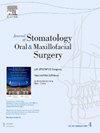The implications of atorvastatin administration and the potential protective role of omega-3 on the submandibular salivary gland of albino rats (Histological, Histochemical, Ultrastructure, and Biochemical Study)
IF 1.8
3区 医学
Q2 DENTISTRY, ORAL SURGERY & MEDICINE
Journal of Stomatology Oral and Maxillofacial Surgery
Pub Date : 2024-09-30
DOI:10.1016/j.jormas.2024.102097
引用次数: 0
Abstract
Background
Hyperlipidemia is a risky condition that can lead to atherosclerosis and other cardiovascular problems. Statins are used to treat hyperlipidemia. The most recommended medicine to treat hyperlipidemia is atorvastatin. On the contrary, clinical trials validated statins' negative effects. Omega-3 fatty acids have antioxidant properties and have been shown to improve a variety of disease processes in the general population, including inflammatory and immunological pathways, various cardiovascular diseases, and lipid regulation. The present research aimed to determine how atorvastatin affected the submandibular salivary gland (SMG) and whether omega-3 may have a protective impact.
Methods
Thirty adult male albino rats were divided into three equal groups and received drugs orally as a single daily dose for one week. Control group (I): received normal saline. Atorvastatin group (II): received a dose of 80 mg Kg-1 of Atorvastatin. Group III: received Omega-3 before Atorvastatin. All rats were sacrificed 2 h following the last dose, and blood samples were gathered for the biochemical study of fasting blood glucose level (FBGL). Specimens were obtained and processed for histological and histochemical studies.
Results
Atorvastatin-treated rats showed degeneration of SMG acini. The acinar cells showed cytoplasmic vacuoles with dilated RER. Histochemical results revealed a marked decrease in total proteins. The biochemical study revealed an elevation in FBGL. The administration of Omega-3 with Atorvastatin minimizes these changes.
Conclusion
Atorvastatin has been proven to induce histological changes in SMG, and these changes can be attenuated by Omega-3. However, Omega-3 has no effect on FBGL.
服用阿托伐他汀的影响以及欧米茄 3 对白化大鼠下颌唾液腺的潜在保护作用(组织学、组织化学、超微结构和生化研究)。
背景:高脂血症是一种危险的疾病,可导致动脉粥样硬化和其他心血管问题。他汀类药物可用于治疗高脂血症。阿托伐他汀是治疗高脂血症最推荐的药物。相反,临床试验验证了他汀类药物的负面影响。奥米加-3 脂肪酸具有抗氧化特性,已被证明可改善普通人群的各种疾病过程,包括炎症和免疫途径、各种心血管疾病和血脂调节。本研究旨在确定阿托伐他汀对颌下腺唾液腺(SMG)的影响,以及欧米伽3是否具有保护作用:方法:将30只成年雄性白化大鼠分为三个等量组,每天单剂量口服药物一周。对照组(I):接受生理盐水。阿托伐他汀组(II):接受剂量为 80 毫克/千克的阿托伐他汀。最后一次给药后 2 小时,所有大鼠均被处死,并采集血液样本用于空腹血糖水平(FBGL)的生化研究。采集标本并进行组织学和组织化学研究:结果:阿托伐他汀治疗的大鼠出现了SMG尖锐湿疣变性。结果表明:阿托伐他汀治疗的大鼠SMG尖突退化,尖突细胞出现胞浆空泡,RER扩张。组织化学结果显示总蛋白明显减少。生化研究显示 FBGL 升高。在服用阿托伐他汀的同时服用奥米加 3 可将这些变化降至最低:结论:阿托伐他汀已被证实会诱发 SMG 的组织学变化,而奥米加 3 可减轻这些变化。然而,欧米伽 3 对 FBGL 没有影响。
本文章由计算机程序翻译,如有差异,请以英文原文为准。
求助全文
约1分钟内获得全文
求助全文
来源期刊

Journal of Stomatology Oral and Maxillofacial Surgery
Surgery, Dentistry, Oral Surgery and Medicine, Otorhinolaryngology and Facial Plastic Surgery
CiteScore
2.30
自引率
9.10%
发文量
0
审稿时长
23 days
 求助内容:
求助内容: 应助结果提醒方式:
应助结果提醒方式:


